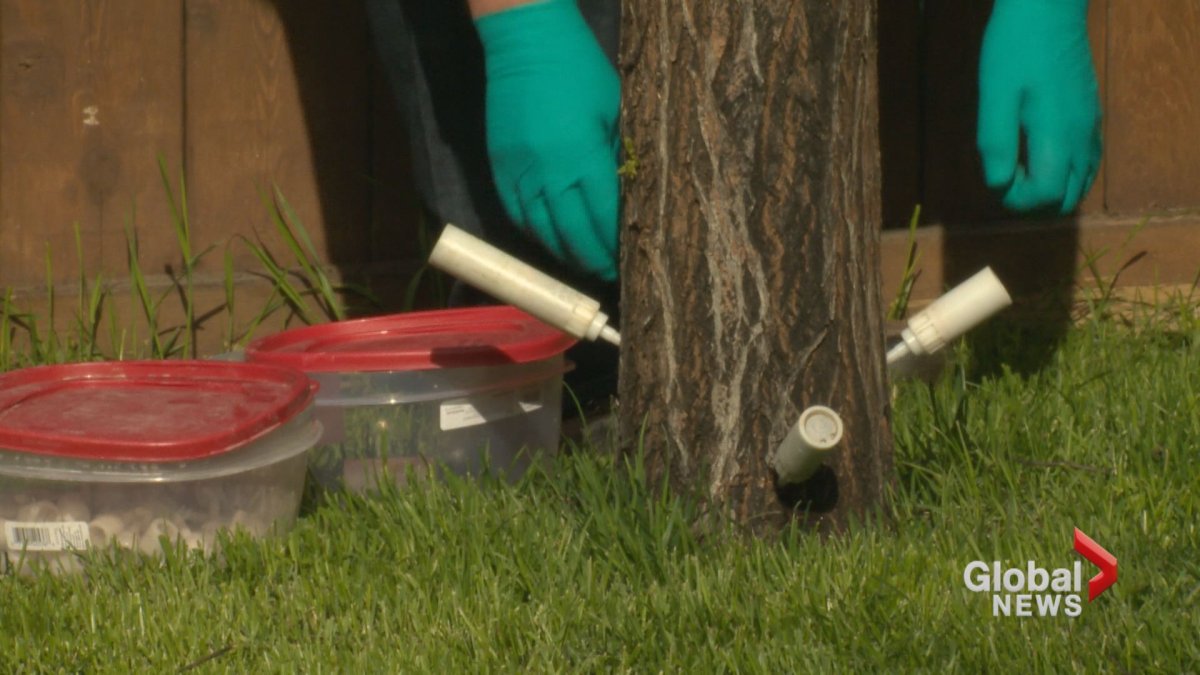Concerns around protecting Calgary’s elm trees are at the forefront this spring as officials try to raise awareness about the invasion of the European elm scale (EES) — a bug that can devastate the tree species.

The pesky insect that is common across elms hibernates for the winter but comes out to feast on branches and sap in spring.
Usually hard to detect early, the little creatures will slowly bring down trees branch by branch. The insects are barely visible to the human eye and are about the size of the point of a pin.
Although the effects of the bugs can also be seen on other trees, they’re most often found on elms. Codie Anderson, a board-certified master arborist with ArborCare, said the key is to look out for the colour of the bark.
“That really is the best cue for the homeowner,” Anderson said. “The black staining — that will allow you to recognize that there’s some other problem going on and get someone to have a closer look.”
But to the untrained eye, the starting infestation is hard to spot, especially on large elms where the branches are farther from the ground.
“The other thing that people typically notice first is actually a bit of honeydew, which comes from the insects themselves, and it drops down to the ground,” Anderson explained. “It’s a bit sticky and from that, you get a bit of mildew that can form on top of it that turns a little bit black.”
According to Julie Guimond, urban forestry lead with the City of Calgary, it’s hard to spot until there is “a heavy, heavy infestation.”
“At that point, it’ll just affect the branch that it’s on,” she said. “The leaves will go brown a bit early, they may drop off a bit early.”
When the infestation is serious, honeydew dropping from the branches will feel like rain if you stand under the tree.
“What it does is slowly sap the vitality of the tree,” Anderson said. “Over time, the branches start to die back.
“Smaller branches and then larger and larger as the infestation gets worse and eventually, you lose the entire elm tree because it just lacks the canopy and the leaves to support itself.”
The pest spreads to other trees from the mold that grows on top of the honeydew and makes its way to nearby surfaces.
Prevention a city and resident responsibility
“Prevention isn’t really something you have control over,” Anderson said. “Either the insects are going to move in or they’re not.
“But what you do want to do is have your elm tree nice and healthy to begin with. So if it gets insects, it’s able to withstand it.”
He added that proper water management and pruning will help the trees.
While the city is working to get ahead of major devastation with early treatment and healthy amounts of water, officials are relying on citizens to report signs of infestation.
“It’s not a huge cost. We put aside our budgets to be able to manage the pruning and we do a lot of proactive pruning in our trees to make sure we keep our trees healthy in the first place,” Guimond said. “We also will go in and treat a select number of elms each year and that’s based on the concerns that we hear.”
The city’s main priority is finding the best solution to stopping EES, but it’s also trying to keep a second pest off its elm trees.
“For us with any pest, it’s a concern. Especially when we have citizens who are worried about it, especially when we have entirely lined streets,” Guimond said.
Dutch elm disease is in a spore that goes inside the tree, carried on the elm bark beetle which the city has worked hard to keep out.
Currently, only a quarter of the elms affected by EES are on public property, the remaining trees fall on private land and are the owner’s responsibility, the city said.
Social media campaign created to ‘get people paying attention’
YYC Tree — an organization focused on saving elm trees, which Anderson is a part of — started a social media campaign hoping to increase awareness and help people understand the early signs of the problem.
“Get people paying attention to the trees, get some treatment. Try and get ahold of the problem before people lose trees,” Anderson said.
“What we’re dealing with some of the more majestic canopy trees in Calgary, they can be the centrepiece of your landscape and there isn’t a need to lose your tree.”
It can cost roughly $150 to $200 to treat one tree, depending on the size and severity of the infestation.
Luckily most infestation handled by injecting the tree with an insecticide and helping it return to full health.
“Keep caring for our forests and keep letting us know when you see concerns,” Guimond said. “And take advantage of the resources we’ve made available for those citizens to keep our entire urban forest really healthy.”
You can check out more information on EES with YYC Tree or the City of Calgary page.





Comments